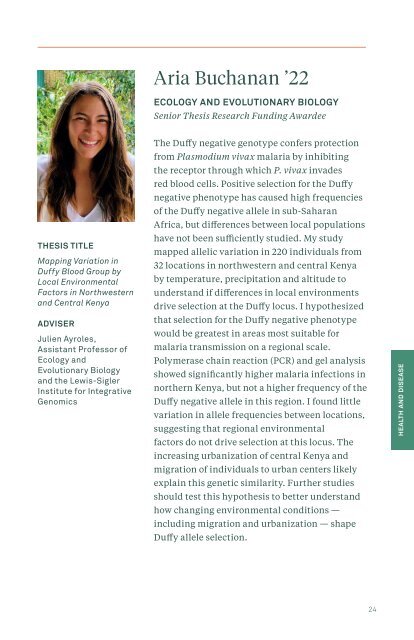Undergraduate Research: An Archive - 2022 Program
Create successful ePaper yourself
Turn your PDF publications into a flip-book with our unique Google optimized e-Paper software.
Aria Buchanan ’22<br />
ECOLOGY AND EVOLUTIONARY BIOLOGY<br />
Senior Thesis <strong>Research</strong> Funding Awardee<br />
THESIS TITLE<br />
Mapping Variation in<br />
Duffy Blood Group by<br />
Local Environmental<br />
Factors in Northwestern<br />
and Central Kenya<br />
ADVISER<br />
Julien Ayroles,<br />
Assistant Professor of<br />
Ecology and<br />
Evolutionary Biology<br />
and the Lewis-Sigler<br />
Institute for Integrative<br />
Genomics<br />
The Duffy negative genotype confers protection<br />
from Plasmodium vivax malaria by inhibiting<br />
the receptor through which P. vivax invades<br />
red blood cells. Positive selection for the Duffy<br />
negative phenotype has caused high frequencies<br />
of the Duffy negative allele in sub-Saharan<br />
Africa, but differences between local populations<br />
have not been sufficiently studied. My study<br />
mapped allelic variation in 220 individuals from<br />
32 locations in northwestern and central Kenya<br />
by temperature, precipitation and altitude to<br />
understand if differences in local environments<br />
drive selection at the Duffy locus. I hypothesized<br />
that selection for the Duffy negative phenotype<br />
would be greatest in areas most suitable for<br />
malaria transmission on a regional scale.<br />
Polymerase chain reaction (PCR) and gel analysis<br />
showed significantly higher malaria infections in<br />
northern Kenya, but not a higher frequency of the<br />
Duffy negative allele in this region. I found little<br />
variation in allele frequencies between locations,<br />
suggesting that regional environmental<br />
factors do not drive selection at this locus. The<br />
increasing urbanization of central Kenya and<br />
migration of individuals to urban centers likely<br />
explain this genetic similarity. Further studies<br />
should test this hypothesis to better understand<br />
how changing environmental conditions —<br />
including migration and urbanization — shape<br />
Duffy allele selection.<br />
HEALTH AND DISEASE<br />
24
















